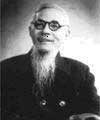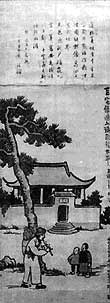Difference between revisions of "Feng Zikai"
imported>Ciic m |
imported>Ciic |
||
| Line 1: | Line 1: | ||
[[File:feng.jpg|thumb|100px|right|Feng Zikai]] | [[File:feng.jpg|thumb|100px|right|Feng Zikai]] | ||
| − | '''Feng Zikai''' | + | '''Feng Zikai''' (丰子恺) (Nov. 9, 1898-Sep. 15, 1975) was a renowned Chinese literati best-known for his modern Chinese paintings, essays, music, cartoons and translations. |
| − | Feng was a | + | In 1927, he followed [[Master Hong Yi]] (弘一法师) to become a Buddhist monk. |
| + | |||
| + | Feng was an advocate of [[China]]’s “New Culture Movement”, which was initiated in a bid to break the philosophical dominance of Confucius that had ruled the country for thousands of years since the [[Han Dynasty]] (206 BC to 220 AD), and introduced Western theories and thoughts. | ||
| + | |||
| + | Feng was considered both noble and honest among the Chinese literary figures when the traditional dragon empire was crashed by Western cannons. | ||
| + | |||
| + | In 1921, he spent a very short stint in Japan studying painting, music and foreign languages, and later returned to [[China]] to focus on education, translation, writing and editing. | ||
| + | |||
| + | A contemporary to [[China]]’s cultural gurus, including [[Mao Dun]], [[Chen Wangdao]], [[Ye Shengtao]], [[Zheng Zhenduo]] and [[Hu Yuzhi]], Feng joined the Lida Academic Society. In 1931, he published his first essay, “Prose on the Courtyard Hall of Predestined Fate” (《缘缘堂随笔》). | ||
| + | |||
| + | He published his cartoon series chronicling the events in [[Japan’s War of Aggression]] in 1937, written while he fled the invading Japanese army. | ||
| + | |||
| + | He was later employed by [[Zhejiang University]] first as lecturer, then as an assistant professor. | ||
| + | |||
| + | Feng ended his career in education in 1943 and became fully engaged with painting and writing. | ||
| + | |||
| + | He had long maintained his painting style that focuses on simplicity and lightness, but the meaning they delineated is rather profound. | ||
| + | |||
| + | However, as was common with many cultural figures during the Cultural Revolution (1966-1976), Feng was seriously tortured amid the political turmoil, whose health was devastated afterwards, according to the biography of his son. | ||
| + | |||
| + | He died of lung cancer in 1975. | ||
| + | |||
| + | Also in his son's biography, Feng had long been surrounded with care and love since childhood, which consequently lead to his passion for life, and was demonstrated in all his works. | ||
| + | |||
| + | “He hid his passion and love in every piece he made,” his peer Yu Pingbo said of him . | ||
[[File:feng1.jpg|thumb|110px|left|Feng Zikai's painting "A Mansion in the Motherland, A Hymn in Praise of Peace"]] | [[File:feng1.jpg|thumb|110px|left|Feng Zikai's painting "A Mansion in the Motherland, A Hymn in Praise of Peace"]] | ||
| − | + | ||
[[Category:Painters]][[Category:Artists]][[Category:Cartoon]][[Category:Art]] | [[Category:Painters]][[Category:Artists]][[Category:Cartoon]][[Category:Art]] | ||
Revision as of 00:55, 15 November 2012
Feng Zikai (丰子恺) (Nov. 9, 1898-Sep. 15, 1975) was a renowned Chinese literati best-known for his modern Chinese paintings, essays, music, cartoons and translations.
In 1927, he followed Master Hong Yi (弘一法师) to become a Buddhist monk.
Feng was an advocate of China’s “New Culture Movement”, which was initiated in a bid to break the philosophical dominance of Confucius that had ruled the country for thousands of years since the Han Dynasty (206 BC to 220 AD), and introduced Western theories and thoughts.
Feng was considered both noble and honest among the Chinese literary figures when the traditional dragon empire was crashed by Western cannons.
In 1921, he spent a very short stint in Japan studying painting, music and foreign languages, and later returned to China to focus on education, translation, writing and editing.
A contemporary to China’s cultural gurus, including Mao Dun, Chen Wangdao, Ye Shengtao, Zheng Zhenduo and Hu Yuzhi, Feng joined the Lida Academic Society. In 1931, he published his first essay, “Prose on the Courtyard Hall of Predestined Fate” (《缘缘堂随笔》).
He published his cartoon series chronicling the events in Japan’s War of Aggression in 1937, written while he fled the invading Japanese army.
He was later employed by Zhejiang University first as lecturer, then as an assistant professor.
Feng ended his career in education in 1943 and became fully engaged with painting and writing.
He had long maintained his painting style that focuses on simplicity and lightness, but the meaning they delineated is rather profound.
However, as was common with many cultural figures during the Cultural Revolution (1966-1976), Feng was seriously tortured amid the political turmoil, whose health was devastated afterwards, according to the biography of his son.
He died of lung cancer in 1975.
Also in his son's biography, Feng had long been surrounded with care and love since childhood, which consequently lead to his passion for life, and was demonstrated in all his works.
“He hid his passion and love in every piece he made,” his peer Yu Pingbo said of him .

